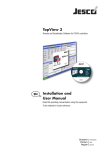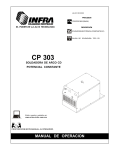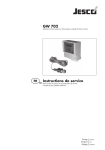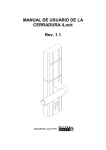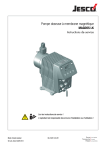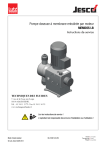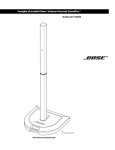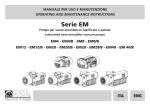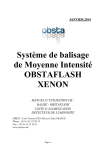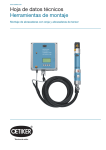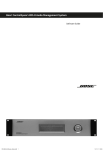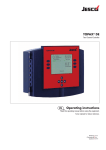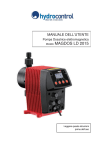Download - Lutz
Transcript
Water Sampling Station PM04 Measurement of free chlorine or chlorine dioxide EN 02 Operation & Maintenance Instructions Read these operation and maintenance instructions before start up! To be held for future reference. Contents 1. General and Safety Instructions........................................................................... 4 1.1 General........................................................................................................... 4 1.2 Warning symbols used in this Operation & Maintenance Manual......................... 4 1.3 Qualification and training of personnel.............................................................. 4 1.4 Important safety instructions............................................................................ 4 1.5 Hazards due to non-compliance with safety instructions.................................... 5 1.6 Safe operation................................................................................................. 5 1.7 Safety instructions for the owner/operator......................................................... 5 1.8 Safety instructions for inspection-, maintenance-, and installation work.............. 5 1.9 Unauthorized modifications and production of spare parts.................................. 6 1.10 General notes of instruction!.......................................................................... 6 1.11 Scope of delivery........................................................................................... 6 1.12 Disposal........................................................................................................ 6 2. Assembly............................................................................................................... 7 2.1 General........................................................................................................... 7 2.2. Measurement of free chlorine and/or chlorine dioxide..................................... 10 2.3. Measuring the “pH-value”, “redox-potentials” and “temperature” . .................. 10 4. Installation.......................................................................................................... 12 4.1 Hydraulic connection..................................................................................... 12 4.2 Electric connection........................................................................................ 14 5. Setting-up........................................................................................................... 15 5.1 Installation of the sensors.............................................................................. 15 5.2 Adjusting the test water quantity..................................................................... 15 5.3 Calibrating the measurement amplifier............................................................ 15 6. Operating............................................................................................................. 17 7. Turning the unit off............................................................................................. 17 8. Maintenance....................................................................................................... 18 9. Technical Data.................................................................................................... 19 10. Installation example......................................................................................... 20 | Operating manual PM04 | Contents 11. Order documents.............................................................................................. 21 11.1. Pre-assembled instrument panel................................................................. 21 11.2. Accessories and spare parts........................................................................ 21 12. Fault analysis.................................................................................................... 22 13. Spare parts........................................................................................................ 23 15. Declaration of harmlessness............................................................................ 29 16. Revision............................................................................................................. 30 17. Warranty............................................................................................................ 31 Contents | Operating manual PM04 | 1. General and Safety Instructions 1.1 General This Operation & Maintenance Manual contains basic information to be noted during installation, operation and maintenance. It is therefore essential that the contractor read the manual before installing and commissioning the pump/system as well as by the relevant operating personnel/owner of the pump/system. It must remain accessible at the dosing pump/system for reference at all times. In addition to the general safety instructions under this main heading of Safety, the special safety precautions outlined another section must also be observed. 1.2 Warning symbols used in this Operation & Maintenance Manual This Operation & Maintenance Manual contains vital information, which may endanger people, the environment and the dosing pump/system if disregarded. These statements are identified by the following symbols: DANGER! Refers to an imminent danger. Non-compliance can lead to death or serious injury. WARNING! Refers to a potentially hazardous situation. Non-compliance can lead to death or serious injury. CAUTION! Refers to a potentially hazardous situation. Non-compliance can lead to minor injury or property damage. NOTICE! or INFORMATION! Appear in conjunction with safety instructions, which may endanger the pump/system and its operation if disregarded. IMPORTANT! Draws attention to supplementary information to make the work easier and ensure trouble free operation. 1.3 Qualification and training of personnel The personnel employed for installation, operation, inspection and maintenance work must be qualified to do so. The areas of responsibility, competence and supervision of the personnel must be precisely defined by the owner. Personnel who do not have the required knowledge must be duly rained and instructed. If necessary, this training can also be provided by the manufacturer/supplier on behalf of the dosing pump’s owner. In addition, the owner of the system must ensure that the relevant personnel are fully familiar with and have understood the contents of this Operation & Maintenance Manual. 1.4 Important safety instructions When installing and using this electrical equipment, basic safety precautions should always be followed, including the following: 1.) Read and follow all instructions! 2.) WARNING! To reduce risk of injury, do not permit children to use this product unless they are closely supervised at all times. WARNING! | Operating manual PM04 | General and Safety Instructions 3.) WARNING! Risk of electric shock. Connect only to a grounding type receptacle protected by a ground-fault circuit-interrupter (GFCI). Contact a qualified electrician if you cannot verify that the receptacle is protected by a GFCI. 4.) Do not bury the cord. Locate the cord to minimize abuse from lawn mowers, hedge trimmers, and other equipment. WARNING! 5.) WARNING! To reduce the risk of electric shock, replace damaged cord immediately. 6.) WARNING! To reduce the risk of electric shock, do not use an extension cord to connect the unit to the electricity supply; provide a properly located outlet. WARNING! 7.) Save these instructions! 1.5 Hazards due to non-compliance with safety instructions Failure to comply with safety instructions may endanger not only people, but also the environment and the dosing pump/system. Non-compliance with the safety instructions can lead to the loss of all entitlement to damages. The following hazard in particular may arise: - Danger to people due to electrical, mechanical and chemical effects. - Failure of system functions. - Danger to the environment due to leakage of hazardous substances. 1.6 Safe operation The safety instructions in this Operation & Maintenance Manual must be observed. The owner is responsible for ensuring the compliance with local safety regulations. 1.7 Safety instructions for the owner/operator Leakages (e.g. due to ruptures in the lining) of hazardous substances (e.g. toxic or abrasive) must be discharged in such a way as to exclude all danger to people and the environment. Statutory regulations must be observed. Danger due to electric current must be excluded (for further details, refer to the German VDE standards as well as local regulations or chapter 1.4). 1.8 Safety instructions for inspection-, maintenance-, and installation work The owner must ensure that all inspection, maintenance and installation work is undertaken by authorized and duly qualified personnel who have also studied this Operation & Maintenance Manual. The dosing pump must always come to a complete stop before starting any work on the pump. The procedure specified in this Operation & Maintenance Manual for shutting down the Dosing/pump/system must be observed without fail. Dosing pumps or systems in contact with potentially harmful media must be decontaminated. All safety mechanisms and guards must be refitted and reactivated as the work is completed. General and Safety Instructions | Operating manual PM04 | WARNING! 1.9 Unauthorized modifications and production of spare parts The device may only be modified or converted in consultation with the manufacturer. Genuine spare parts and accessories authorized by the manufacturer ensure greater safety. The use of other parts can void the liability for the subsequent consequences. 1.10 General notes of instruction! Measuring cables must not be laid parallel or close to power supply or high-voltage current lines. Interferences would mutilate the measurement. At close distances, power supply and measuring lines may only cross at a 90° angle. The admissible length of the measuring cables must be adhered to with regard to the sensor used. It is of decisive importance whether high-impedance (e.g. pH value) or low-impedance (e.g. free chlorine sensor) measurements are carried out. In the case high-impedance measurements, make sure that the (plug) connections are clean and dry (plug) and the lines do not become brittle due to sharp buckling. The screened cables normally used for such measuring lines must be handled according to the prescribed quality. Screening may only be connected to ground at one end of the cable (preferably at the controller). Interface lines must be twisted and screened (see recommended cables). IMPORTANT! IMPORTANT! If possible, a continuous cable from sensor to measuring input should be used. An extension of the cable by plugs or terminal socket increases the risk of disturbances due to contamination, humidity or excessive transition resistances. 1.11 Scope of delivery IMPORTANT! Please unpack the product and ordered accessories with great care in order not to miss any small parts. Immediately compare the scope of delivery with the delivery note. The cause of any discrepancies must be determined. IMPORTANT! 1.12 Disposal Should the device need to be permanently taken out of operation, please bear in mind that it contains electrolytic capacitors and must therefore be disposed of accordingly. | Operating manual PM04 | General and Safety Instructions 2. Assembly 2.1 General For hygiene reasons the drinking water or other water with which people come in direct contact has to be treated frequently with agents that kill off any micro organisms contained therein. Chlorine or chlorine compounds are mainly used for this purpose as “disinfectants”. A high level of safety is an absolute necessity for the user in this sensitive area, therefore one uses devices that fully automatically monitor, regulate and record the concentration of disinfectant. To measure the amount of free chlorine or chlorine dioxide, ampere-metric sensors are fitted in the PM04 instrument panel (3 electrode systems for a potentiostatic operating mode). Depending on the level of the assembly further water parameters can be measured, such as pH-value, redox-potentials and the temperature. An electronic controller, e.g. the TOPAX model, which shows and evaluates the sensor values, can be fitted directly onto the instrument panel. This provides a compact measuring and regulating unit to control the actuating elements like the regulating valve or dosing pump. IMPORTANT! The “test water channel “ is of crucial importance for perfect “measuring results”. Therefore, before installing, carefully read through the information in particular regarding hydraulic installation. Assembly | Operating manual PM04 | IMPORTANT! 30 Controler optional 670 730 O,9 30 20 280 320 Fig. 2.1: Dimensional drawing of the PM04 | Operating manual PM04 | Assembly 20 Depending on the design, the sensors are fitted in a transparent “multi-functional control block”. In detail, it concerns the following functions: 11 10 7 4 8 3 12 2 13 1 9 6 5 14 Fig. 2.2: View of the multi-functional control block Key: ① measuring water inflow ② filter ③ needle valve DN 2,5 ④ central drainage pipe of the overflow piping ⑤ pivoting drainage pipe for manual water testing ⑥ excess chlorine measurement cell ⑦ reference electrode for excess chlorine measurement cell ⑧ floating elements with bar magnet ⑨ dry reed contact ⑩ potentials-adjustment pin ⑪ receptacle holes for the pH- and REDOX-single-rod measuring cell ⑫ receptacle holes for the temperature gauge Pt100 ⑬ water drainage from the measurement cell with PVC-pipe ⑭ collection hopper Assembly | Operating manual PM04 | 2.2. Measurement of free chlorine and/or chlorine dioxide The measuring of excess chlorine works in accordance with the ampere-metric measurement principle with free measuring electrodes, i.e. the measuring electrode is in direct contact with the test water. Ampere-metric sensors can be divided by the following criteria: • 2-electrodes system • 3- electrodes system with potentiostatic connection A potentiostatic measuring cell is fitted on the PM 04 instrument panel to measure the concentration of disinfectant. It contains a “gold electrode” as a measuring electrode, a (high-grade steel electrode” as a backing electrode and a “glass reference electrode” (KCI). The potentiostatic connection is integrated in the corresponding measurement amplifier. A specific D.C. voltage is set on the measuring cell by the potentiostatic connection in the measurement amplifier, which polarises the measurement cell. It is therefore not necessary to zero calibrate this cell. The current only flows with the addition of free chlorine and/or chlorine dioxide. This current increases proportionally to the concentration. The content of disinfectants is verified and the measurement amplifier is calibrated with the help of the comparative measurement as per the DPD1 method. The excess chlorine measurement is heavily dependent on the pH-value. Consequentially there is a need for the constant pH-value of the water to be analysed to be at preferably pH 7.20 or lower. Otherwise the same chlorine content would give different readings. The condition of the chlorine in the water changes depending on the pH-value and therefore so does the measurement signal. At pH 7.00 approx. 20% of the free chlorine is dissociated into hypochlorite (CIO-), and at 8.00 pH already about 80%. Hypochlorite (ClO-) only has a small disinfecting effect and therefore only produces a smaller current at the measurement cell. The chlorine dioxide measurement only depends to a lesser extent on the pHvalue. In the potentiostatic measurement cell of the PM 04 instrument panel, rotating balls in the water current ensure the continuous cleaning of the electrodes. After the intake phase of a couple of hours they secure a long-term stability of the chlorine measurement. It is not necessary to clean the measuring cells by hand at specific intervals. 2.3. Measuring the “pH-value”, “redox-potentials” and “temperature” The receptacle holes for the pH and redox single-rod measuring cells and a Pt100 temperature sensor are located in the transparent flow-through casing. The sensors are screwed directly onto the flow-through casing. The single-rod measuring cells can be hung up with mounting plates on the acrylic-block during calibration. 10 | Operating manual PM04 | Assembly 3. Functions All of the following functional units of the instrument panel are located in a transparent multi-functional control block: • potentiostatic chlorine measurement cells with electrode cleaning without zero point calibration • pH- and Redox- single-rod measuring cells (depending on the design) • hydrostatic through flow with vapour lock- separator for an even through current for the measurement cell • Test water filter to protect the measurement cell from abrasive dirt • Fine tuned valve to adjust the water current • Flow through monitoring – contact “test water deficiency” for the controller • Potentials-adjustment pin to discharge unwanted and disruptive foreign potentials. • Sample withdrawal for manual water testing when calibrating Functions | Operating manual PM04 | 11 4. Installation If a measurement amplifier or controller is installed on the instrument panel, then it has to be mounted at such a height on the wall that the operator can read off the controller and operate the electronic automatic controller with ease. The test water must be able to drain down freely from the panel. Use the screws and washers provided to fix it to the wall. These are purpose made with regard to the size and material of this application. Install the instrument panel without mechanical tension! The nuts are to be adjusted on the threaded rods in such a way that all four fixing points are all on one level. 4.1 Hydraulic connection 4.1.1. Water inflow The test water travels through plastic tubes or hoses made of PVC or PE. Under no circumstances may metal tubes be used, as they can falsify the measurement through chlorine loss through shrinkage. The test water must be carried to the instrument panel with as little deceleration as possible, so that it is possible to control the water quality well. Brief dead times are attained by using the shortest possible hoses and smallest possible cross sections. 50 metre long pipes DN 6 already yield approx. 2 minutes of dead time. If the pipe’s cross section were widened to DN 15 due to losses from friction in the pipes, then the dead time increases to approx. 10 minutes. Therefore it is recommended for when there are great distances between the withdrawal of the test water and the instrument panel, to build an installation as per the following diagram (fig. conduit with water pump gauge). The use of a measuring water pump is useful if the test water is not flowing through with enough pressure (at least 0.2 bar at the connection with the instrument panel). Long periods of deceleration due to the great distance between the withdrawal point and the measuring panel, can be avoided, too, by using measuring water pumps. The pump pushes the test water over the long distance in a ring circuit to the instrument panel and only one component current is taken for the actual measurement. Under no circumstances may the throttle valve be closed, as otherwise very long deceleration periods hinder the control. In addition the water in the pump is warmed up a lot and can lead to measurement errors. It is helpful having a manometer in the circuit ring when adjusting the throttle valve. When withdrawing test water (see fig. 4.2.) the applicable regulations have to be observed. When withdrawing test water from a pipe it must be done from the line’s centre as shown in the diagram. 12 | Operating manual PM04 | Installation z.B. 50 m DN15 DN 6 Fig. 4.1: Conduit with water pump gauge Fig. 4.2: Water withdrawal gauge Installation | Operating manual PM04 | 13 4.1.2. Water drainage The drainage of water from the instrument panel is free from pressure. Two streams of water run off the acrylic-block, one from the overflow pipe and one from the actual measurement cell. Both of the water streams are pooled together in the collection hopper at the bottom left hand corner of the instrument panel. The water for the manual tests is withdrawn at the pivoting drainage pipe. The water from the hopper must be able to drain downwards freely. The recirculation of water in a pressure system is possible with a submerged pump in a collection tank, for instance (see installation example). 4.2 Electric connection The local (DIN, VDE, ...) must be observed for the general electric installation. A specialist must always carry out the electrical work. The controller and/or measurement amplifier should be installed directly on to the instrument panel and/or for the installation of the control cabinet as near to the instrument panel as possible. The connecting lines for the pH- and redox single-rod measuring cells, in particular, should not be any longer than approx. 10 cm without any special precautions. If larger distances have to be bridged, an impedance transformer then has to be put on the electrode. Under no circumstance may the measuring cables be laid directly parallel to the power and control lines or their pipe ducts, junctions have to be at a 90° angle. Equipotential bonding is necessary if the tension introduced causes measuring errors, especially in the chlorine and pH measurements. The sensors are directly connected to the measurement amplifier via terminal blocks. WARNING! IMPORTANT! WARNING! Measuring cables must not be laid parallel to or in close proximity to the power lines and/or high-voltage lines. Interfering random agents distort the measurement. Power lines and measuring lines may only cross at close proximity at right angles. The permissible length for the measuring line is to be considered with the given sensor in mind. It is of crucial importance to know whether it concerns high-impedance (e.g. pH-value) or low impedance (e.g. surplus chlorine measurement cell) measurements. For high impedance measurements pay particular attention to ensuring that the connections and/or plug socket are clean and dry, and that the lines are not weakened by major kinks. The shielded cables normally used for such measuring lines have to be used in the prescribed quality. IMPORTANT! If possible a continuous length should be used from the sensor to the measured value input. Extending the cable with connectors and/or connection boxes increases the risk of disturbances through contamination, humidity or transfer resistance. 14 | Operating manual PM04 | Installation 5. Setting-up 5.1 Installation of the sensors During the transport a plastic rod is inserted in place of the reference electrode, this stops the glass ball from falling out of the measuring cell. The rod is removed along with the clamping screw connection and the reference electrode is screwed in. Prior to this the Oring supplied, approx. 30 cm, is slid onto the reference electrode and serves as a centring device. WARNING! When installing the reference electrode the test water may not flow, so that the glass ball is not flushed out of the chlorine measurement cell. The pH and chlorine single-rod measuring cells are fitted from above in the acrylic-block, the temperature sensor if necessary, below on the side with a smaller clamping screw connection. The cable’s connection to the pH and redox single-rod measuring cells has to be attached with great care. Even the smallest amount of contamination or humidity leads to false measuring results. WARNING! INFORMATION! The protective caps for the glass electrodes should be removed. They are needed when the instrument panel is shutdown to stop the electrodes getting damp. INFORMATION! 5.2 Adjusting the test water quantity The needle valve on the acrylic-block is set up in such a way, that some water drains off in the overflow pipe. Fluctuations in the system’s pressure are to be expected (for example, when the pumps are turned off overnight), so the needle valve has to be adjusted at the lowest system pressure, so that enough flows through the measurement cell. If sufficient test water flows, the glass balls in the chlorine measurement cell start to rotate in the same way, the floats come up and the dry-reed contacts connect. This signals to the electric controller that there is enough test water current and that the adjustment control can be enabled. 5.3 Calibrating the measurement amplifier Before the measurement amplifier is calibrated, the test water should flow for about an hour, as the excess chlorine measurement cell needs an inflow phase before a stable measurement value can be given out. The measurement amplifier is calibrated with the same procedure regardless of its make. The detailed procedure is to be taken from the user manual for the measurement amplifier and/or controller. Before the excess chlorine measurement cell is calibrated the pH value should be constant as varying pH values from the chemical procedures in the water create different chlorine ions and thereby different measurements of chlorine (the chlorine measurement’s dependence on the pH-value is described in point 2.2.). Setting-up | Operating manual PM04 | 15 WARNING! The pH-value has a decisive influence on the chlorine measurement! WARNING! pH-Value In order to calibrate the pH-measurement amplifier one requires two buffer solutions. They should isolate the anticipated test range, (e.g. buffer solutions pH 6.8 and pH 9.28 for test values of pH 7.2). During the calibration the pH-single-rod measuring cell can be hung up on the mounting plates in the acrylic block. REDOX- Potentials Only one buffer solution is required to calibrate the REDOX- measurement amplifier. During the calibration the REDOX-single-rod measuring cell can be hung up on the mounting plates in the acrylic block. WARNING! Buffer solutions only last for a limited amount of time. Once they expire the calibration of the sensors is unreliable. WARNING! Chlorine and/or chlorine dioxide measurement cells Free chlorine and/or chlorine dioxide are measured with the same measurement cell. It is not necessary to zero point calibrate with the potentiostatic measurement cell with 3 electrodes. This only needs to be done if either the zero point on the measurement amplifier is moved or if the measurement amplifier implicitly requires a zero point calibration. The “zero-status” of the measurement cell is achieved by disconnecting the cable from the gold electrode. After the zero-point calibration is complete the cable is connected again. If the displayed value is set at a stable value then the slew-rate calibration can be carried out. This can take a few minutes. To perform the slew-rate calibration a water sample is taken from the pivot pipe on the overflow of the measurement cell and the content of the effective chlorine and/or chlorine dioxide ions is determined manually. For this purpose a photometer is usually used, that works according to the DPD method. The user manual for the photometer has to be followed to the letter and regard must be given to cleanliness. Dirty cuvettes or fingerprints on the cuvette can cause huge errors in the measurements. The value determined manually is immediately set in the measurement amplifier. WARNING! WARNING! For the first run the chlorine and/or chlorine dioxide measurement has to be calibrated again after one to two days. During this time the surface of the electrodes adapts to the chemical and mechanical operating conditions. 16 | Operating manual PM04 | Setting-up 6. Operating When it is operating one must be careful that there is always some water flowing out of the overflow pipe. If necessary the needle valve has to be opened a little further. The measurement has to be checked every week unless there are local regulations stipulating shorter intervals. If need be the measurement inserts should be calibrated again. In the same cycle a visual check should be made on the filters in the test water inflow. If they are dirty they have to be cleaned and/or replaced, in order to avoid false measurement readings through the loss of chlorine in the filters. 7. Turning the unit off For short interruptions to the operation, the water flow through the measurement cell should not be stopped. An oxide coating forms on the outer surface of the electrodes, the rotating balls remove this when the operation starts again. It is then seen as a new inflow phase of the chlorine measurement cell. For longer shutdown periods over several days we recommend to empty the water out of the control block and to dry out the chlorine measurement cell. The reference electrode and the pH and REDOX- single-rod measuring cell are to be disassembled and stored accordingly. WARNING! Be careful not to lose the glass balls when dismantling the electrodes Before the pH- and REDOX- and reference electrodes are dried out they must first be protected. To do this, the rubber protective cap and/ or storage tank supplied (depending on the type of measurement section) are filled with KCI solution and put on the electrodes. The electrodes are stored vertically. Operating | Turning the unit off | Operating manual PM04 | 17 WARNING! 8. Maintenance The annual maintenance work is limited to a visual inspection of all the components and if necessary the cleaning of the control block with a replacement of the washers. The service life of the single-rod measuring cell depends on the operating conditions and the properties of the water (e.g. corrosiveness, grease, etc.). They normally last about 12 to 15 months, whereby a 50% storage time is counted on. When re-assembling the reference electrode ensure that the O-ring is mounted on the glass shaft. The gold and high-grade steel electrodes can have a service life of several years, depending on the corrosiveness and abrasiveness of the water. They only have to be replaced when there are strong signs of wear (e.g. very thin points on the gold wire). If there are strong impurities on the surface of the metal, these can be carefully removed with a fine emery cloth (e.g. grit 800). The nozzle for the incoming flow of the potentiostatic measurement cell can be pulled out from the side with a M5 threaded rod to clean and then be installed again. After dismantling the complete block, the upper catch of the floating element has to be positioned again. To check the switching function the electrical through-flow of the dry reed contact is verified. (Floating elements above: contact closed, floating elements below: contact opened). If the switching function does not work after the upper catch has been adjusted, then the dry reed contact can be moved to the fine alignment in the clamping screw connection. INFORMATION! Electro-chemical sensors are wear and tear parts and are not covered by the warranty terms. . INFORMATION! 18 | Operating manual PM04 | Maintenance 9. Technical Data Water test panel Mesh aperture of the filter mm 0.5 Water requirement l/h approx. 45 Temperature °C maximum 45 Water inflow mm hose connection ø 6 (0.2..6 bar) Water drain mm hose connection ø 10 (drain in free downward incline) Dimensions mm 320x680x105 (WxHxD) Potentiostatic excess chlorine measurement cell Test range mg/l 0...2.00 (free chlorine) 0...1.00 (chlorine dioxide) pH – range pH 5.5...8.0 (only for chlorine measurement) Electrode materials Measuring electrode gold Backing electrode high-grade steel Reference electrode KCl-gel filling pH-single rod measuring cell Test range pH 0.00 – 14.00 mV - 1000 – +1000 REDOX-single-rod measuring cell Test range Technical Data | Operating manual PM04 | 19 10. Installation example 5 7 4 6 11 10 8 2 9 1 LS M 3 Fig. 10.1: Installation example Key: ① Test water withdrawal ② Instrument panel PM04 ③ Pump for test water recirculation ④ Dosing pump pH- adjustment ⑤ Injection point pH- adjustment ⑥ Jet pump with check valve ⑦ Drive-water pump ⑧ Chlorine gas – control valve ⑨ Chlorine gas – flow meter ⑩ Introduction of chlorine solution ⑪ Drive-water rate 20 | Operating manual PM04 | Installation example 11. Order documents 11.1. Pre-assembled instrument panel Model Order no.. PM 04 to measure free chlorine and/or chlorine dioxide: potentiostatic measurement cells with gold-, high-grade-, reference-electrodes 42200010 PM 04 to measure free chlorine and/or chlorine dioxide, pH-value potentiostatic measurement cells with gold-, high-grade-, reference-electrodes pH-single-rod measuring cell with 1.50cm measuring cable 42200011 PM 04 to measure free chlorine and/or chlorine dioxide, pH-value, temperature potentiostatic chlorine measurement cells with gold-, high-grade-, reference-electrodes and balls to clean the electrodes pH-single-rod measuring cell with 1.50cm measuring cable temperature gauge Pt100 with 2.5m connection cable 42200012 PM 04 to measure free chlorine and/or chlorine dioxide, pH-value, REDOX potentiostatic chlorine measurement cells with gold-, high-grade-, reference-electrodes and balls to clean the electrodes pH-single-rod measuring cell with 1.50cm measuring cable Redox-Electrode with 1.50cm measuring cable 42200013 PM 04 to measure free chlorine and/or chlorine dioxide, pH-value, REDOX temperature potentiostatic chlorine measurement cells with gold-, high-grade-, reference-electrodes and balls to clean the electrodes pH-single-rod measuring cell with 1.50cm measuring cable Redox-Electrode with 1.50cm measuring cable temperature gauge Pt100 with 2.5m connection cable 42200014 11.2. Accessories and spare parts Model Order no. Reference electrodes for the potentiostatic measuring cell 41100060 pH-single-rod measuring cell with N-cable cap screw PG 13.5 and separate connection cable 41100004 Redox- single-rod measuring cell with N-cable cap screw PG 13.5 and separate connection cable 41100011 Temperature gauge Pt 100 with fixed cable 2.5m 41100022 Special measuring cable with N-socket link for pH-value and REDOX single-rod measuring cells; 0.60m long for instrument panel. 78103 Order documents | Operating manual PM04 | 21 12. Fault analysis Type of fault Possible cause Eliminating the fault Balls in the chlorine measurement cell rotate too slowly and/or floating elements do not float Inflow water pressure too low Install test water line with a larger cross section. WARNING! observe delay time Install a measuring water pump (see 4.1 Hydraulic connection) Installation Floating elements float up, but the dry reed contact does not switch to channel pass The display of the connected measurement amplifier varies erratically and does not concur with the comparative measurement Filter in the test water line or in the control block is dirty Clean the filter set and/or replace it Blocked needle valve Fully open the needle valve once and install again Inflow nozzle of the chlorine measurement cell is very dirty Clean the nozzle (see 9. Maintenance) The chlorine measurement cell’s reference electrode is not centred in the hole Fit an O-Ring on the reference electrode (see 5.1 Installation of the Sensors) The adjustment between the floating elements and the dry reed contact is wrong Align the upper catch for the floating elements (see 9. Maintenance) move poss. reed contact in the clamping screw connection Dry reed contact defect Replace the dry reed contacts In particular during excess chlorine measurement: varying pH-values strongly affects the chlorine measurement disproportionately. (with the DPD- manual measurement even with lower pH the active chlorine in the water is not ascertained and so a higher value of free chlorine is simulated). Stabilise the pH-value in the water (e.g. optimise control path, control parameters) 22 | Operating manual PM04 | Fault analysis 13. Spare parts potentiostatic excess chlorine measuring cells (single electrodes) Electrode Order no. Reference electrode with 1.5m fixed cable and O-Ring to centralise in the acrylic-block 41100060 Gold electrode 34168 High-grade steel electrode 34146 4,5 1,2 6 7 9 10 2,11 3 8 2 12 1,2 5,13 5 25 1,2 27 20 2,14 15,16 17 18 26 5 19 24 20 Potentiostatic Measuring Cell see draft 13.2 (Spare parts to assemble the electrodes of the potentiostatic measurement cell) 21 22 23 24 Fig. 13.1: Spare parts for the complete multi-control block Spare parts | Operating manual PM04 | 23 Spare parts for the complete multi-control block Pos. Piece Description Order no. 1 3 Screw connection M12x1.5 78232 Alternative blank plugM12x1.5 78235 2 5 O-Ring d12x2 80058 3 1 Dry reed contact with cable 2.5m 25070 4 2 Screw connection Pg 13, 33906 Alternative blank plugM12x1PG 13,5 78883 5 4 O-Ring d20, 35x1.78 80001 6 1 Potentials adjustment pin 35177 7 1 Screw connection PG 13,5 33906 8 1 Floating elements d8, 3x42mm 34145 9 1 Standpipe cpl. with reducer and O-Ring 35418 10 1 Control-block 34168 11 1 Valve inset 34183 12 1 Valve spindle 34182 13 1 Threaded connectors G 1/2 35709 14 1 Blank plug M12x1.5 78235 15 1 Slit nozzle 34184 16 1 O-Ring d7x1 80782 17 1 Upper filter withdrawal 34181 18 1 Filter tray 88093 19 1 Lower filter withdrawal 34180 20 2 O-Ring d12, 4x2.62 80004 21 1 Coupling nut G 5/8 82087 22 1 Bonding connection d12i 82013 23 1 Hose connector for hose d6 18266 24 2 Hose clamp 8...15 82398 25 1 Reducer G 5/8a-G1/2a 34166 26 1 Pipe clamps d25 13606 27 1 Hopper with hose connector d10 34167 29 2 O-Ring 10x2 80384 24 | Operating manual PM04 | Spare parts Spare parts to assemble the electrodes of the potentiostatic measurement cell 13 11,12 9 2 1 5,6 2 8 5,6 14 7 3,4 3,4 10 Fig. 13.2: Spare parts to assemble the electrodes of the potentiostatic measurement cell Pos. Piece Description Order no. 1 1 O-Ring d12x2 81384 2 2 Clamp ring for electrodes 34179 3 6 Cylinder head screw M4x20 DIN 912 83187 4 6 Washer d4.3 DIN 125 84201 5 2 Ring guide M4 77578 6 2 Cylinder head screw M4x8 DIN 912 83016 7 1 Gold-electrode cpl. 34148 8 1 High-grade steel-Electrode 34146 9 1 Reference Electrode 34187 10 1 Ball set (200 St.) 31613 11 3 Cylinder head screw M5x65 DIN 912 83756 12 3 Washer d5.3 DIN 125 84202 13 3 Separating washer d20/5,5x25 34185 14 2 O-Ring d25x3 80138 Spare parts | Operating manual PM04 | 25 14. Index A Accessories..............................................................................................................21 Adjusting the test water quantity................................................................................15 Assembly...................................................................................................................7 C Calibrating................................................................................................................15 chlorine dioxide...........................................................................................................7 D drinking water.............................................................................................................7 F Fault analysis............................................................................................................22 free chlorine...............................................................................................................7 Functions.................................................................................................................11 H Hydraulic connection.................................................................................................12 I Installation................................................................................................................12 Installation example..................................................................................................20 Installation of the sensor............................................................................................15 M Maintenance.............................................................................................................18 Measurement...........................................................................................................10 measurement cells....................................................................................................16 O Operating.................................................................................................................17 Order documents......................................................................................................21 26 | Operating manual PM04 | Index P pH-value..................................................................................................................10 R redox-potentials........................................................................................................10 S Safety Instruction........................................................................................................4 Setting-up................................................................................................................15 Spare parts...............................................................................................................23 T Technical Data..........................................................................................................19 temperature.............................................................................................................10 Turning the unit off....................................................................................................17 U unpack.......................................................................................................................6 W Water drainage.........................................................................................................14 Index | Operating manual PM04 | 27 28 | Operating manual PM04 | Index 15. Declaration of harmlessness Please copy and send in with your device! Please display anon the outer packaging! Declaration of harmlessness (please fill out a separate form for each appliance) We forward the following device for repairs: Type of device: ___________________________________________________________________ Part-no.: ________________________________________________________________________ Order-no.: _______________________________________________________________________ Delivery date: ____________________________________________________________________ Reason for repair: _________________________________________________________________ ______________________________________________________________________ Medium used:_____________________________________ Properties: irritant: yes/no corrosive: yes/no We hereby certify that the machine has been thoroughly cleaned inside and out before its dispatch and that it is free from health risk chemical, biological and radioactive materials as well as having been drained of oil. *) If the manufacturer find it necessary to carry out further cleaning work, we accept the charge will be made to us. We certify that the aforementioned information is correct and complete and that the unit is dispatched in compliance with legal requirements. Company / address: Customer-number: Contact person: Phone: Fax: E-Mail: ________________________ Date _ ____________________________ Signature / stamp *) If not applicable please cross out! Declaration of harmlessness | Operating manual PM04 | 29 16. Revision This Operating Manual is valid for the following devices: Gerät und Typ Revisions-Stand Software-Version PM04 4.2007 1.0 It contains all the technical information required for installation, start-up and maintenance. Should you have any questions or require further informations regarding these operating instructions, please contact the manufacturer or its official national representative. 30 | Operating manual PM04 | Revision 17. Warranty Relays for the main voltage switch have to be protected from damages through demolishing sparks, by a wireless quenching circuit. Please copy and send with the device. If the device breaks down within the period of warranty, please return it in a cleaned condition with the complete warranty application, filled out. Sender Company:................................................................ Phone:....................................Date:................................... Address:.......................................................................................................................................................... Contact person:............................................................................................................................................... Lutz-Jesco order-no.:............................................... Delivery date:.................................................................... Device type:............................................................. Serial no.:......................................................................... Nominal capacitynominal pressure:................................................................................................................... Description of fault:......................................................................................................................................... ..................................................................................................................................................................... ..................................................................................................................................................................... Type of fault: 1. Mechanical fault 2. Electrical fault - premature wear - loose connections such as plug connector or cable - wear parts - operating elements (e.g.. switches/buttons) - breakage/other damage - electronics - corrosion - damage in transit 3. Leaks . 4. No or inadequate suction - connections - defective diaphragm - dosing head - other Service conditions of the dosing pump Point of use / system designation:.................................................................................................................... Accessories used (Suction line, PDS, etc.):........................................................................................................ ..................................................................................................................................................................... ..................................................................................................................................................................... Commissioning (date):..................................................................................................................................... Duty peroid (approx. operating hours):.............................................................................................................. Please describe the specifics of the installation and provide a simple diagram with details of the material, diameter, length and levels. Warranty | Operating manual PM04 | 31 Lutz-Jesco GmbH Am Bostelberge 19 30900 Wedemark Germany Phone: +49 5130 5802-0 Fax: +49 5130 5802-68 E-Mail: info@lutz-jesco.de Internet: www.lutz-jesco.de 24h-Hotline: +49 5130 580 280 Austria Great Britain Netherlands Hungary Lutz-Jesco GmbH Lutz-Jesco (GB) Ltd. Lutz-Jesco Nederland B.V. Lutz-Jesco Üzletág Aredstraße 29/212 2544 Leobersdorf Austria Gateway Estate West Midlands Freeport Birmingham B26 3QD Great Britain Nijverheidstraat 14 C 2984 AH Ridderkerk Netherlands Vasvári P. u. 9. 9024 Györ Hungary Phone: +43 2256 62180 Fax: +43 2256 6218062 E-Mail: info@lutz-jesco.at Internet: www.lutz-jesco.at Phone: +44 121 782 2662 Fax: +44 121 782 2680 E-Mail: info-gb@jesco.de Internet: www.lutz-jesco.de Phone: +31 180 499460 Fax: +31 180 497516 E-Mail: info@lutz-jesco.nl Internet: www.lutz-jesco.nl Phone: +36 96 523046 Fax: +36 96 523047 E-Mail: info-hu@jesco.de Internet: www.lutz-jesco.hu USA East Asia Middle East Lutz-JESCO America Corp. Lutz-Jesco East Asia Sdn Bhd Lutz-Jesco Middle East FZE 55 Bermar Park Rochester, NY 14624 USA Phone: +1 585 426-0990 Fax: +1 585 426-4025 E-Mail: mail@jescoamerica.com Internet: www.jescoamerica.com Taman Perindustrian Jaya 47200 Petaling Jaya Malaysia P.O. Box 9614 SAIF-Free Zone Center Sharjah UAE Phone: +603 78454812 Fax: +603 78458413 E-Mail: info@lutz-jescoasia.com Internet: www.lutz-jescoasia.com Phone: +971 6 5572205 Fax: +971 6 5572230 E-Mail: info-me@jesco.de Internet: www.jescome.com Best.-Nr. BA-42200-02-V02 Subject to technical changes © Lutz-Jesco GmbH 08.2007 Printed in Germany
































